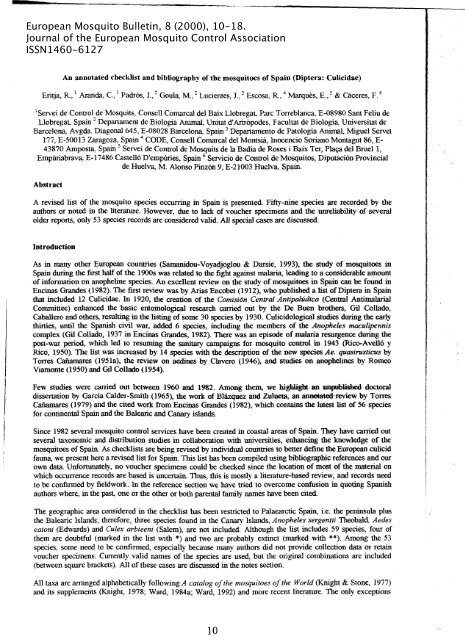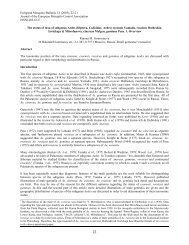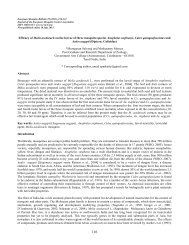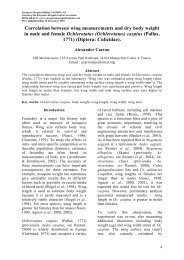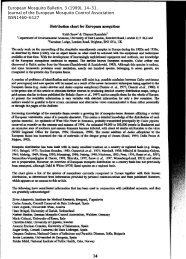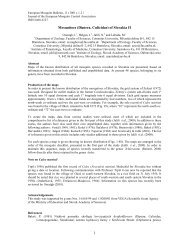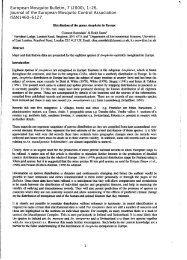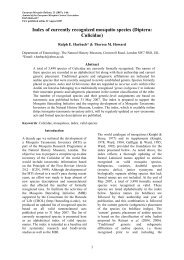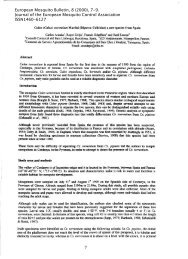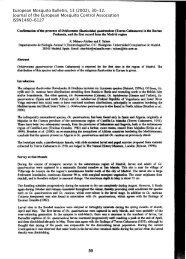European Mosquito Bulletin, 8 (2000), 10-18. Journal of the ...
European Mosquito Bulletin, 8 (2000), 10-18. Journal of the ...
European Mosquito Bulletin, 8 (2000), 10-18. Journal of the ...
You also want an ePaper? Increase the reach of your titles
YUMPU automatically turns print PDFs into web optimized ePapers that Google loves.
<strong>European</strong> <strong>Mosquito</strong> <strong>Bulletin</strong>, 8 (<strong>2000</strong>), <strong>10</strong>-<strong>18.</strong><br />
<strong>Journal</strong> <strong>of</strong> <strong>the</strong> <strong>European</strong> <strong>Mosquito</strong> Control Association<br />
ISSN1460-6127<br />
An annotated cbecklist and bibliograpby <strong>of</strong> tbe mosquitoes <strong>of</strong> Spain (Diptera: Culicidae)<br />
Eritja, R, ] Aranda, c.,] Padr6s, J., 2 Goula, M.,2 Lucientes, J., 3 Escosa, R, 4 Marques, E., 5 & C3ceres, F. C<br />
IServei de Control de Mosquits, Consell Comarcal del Baix Llobregat, Pare Toneblanca, E-08980 Sant Feliu de<br />
Llobregat, Spain 2 Departarnent de Biologia Animal, Unitat d'Artropodes, Facultat de Biologia, Universitat de<br />
Barcelona, Avgda. Diagonal 645, E-08028 Barcelona, Spain 3 Departamento de Patologia Animal, Miguel Servet<br />
177, E-50013 Zaragoza, Spain 4 CODE, Consell Comarcal del Montsia, Inocencio Soriano Montagut 86, E-<br />
43870 Amposta, Spain 5 Servei de Control de Mosquits de la Badia de Roses i Baix Ter, Pla~ del Brnell,<br />
EmpUriabrava, E-17486 Caste1l6 D'empUries, Spain 6 Servicio de Control de <strong>Mosquito</strong>s, Diputaci6n Provincial<br />
de Huelva, M. Alonso Pinz6n 9, E-2<strong>10</strong>03 Huelva, Spain.<br />
Abstract<br />
A revised list <strong>of</strong> <strong>the</strong> mosquito species occurring in Spain is presented. Fifty-nine species are recorded by <strong>the</strong><br />
authors or noted in <strong>the</strong> literature. However, due to lack <strong>of</strong> voucher specimens and <strong>the</strong> unreliability <strong>of</strong> several<br />
older reports, only 53 species records are considered valid. All special cases are discussed.<br />
Introduction<br />
As in many o<strong>the</strong>r <strong>European</strong> countries (Samanidou-Voyadjoglou & Darsie, 1993), <strong>the</strong> study <strong>of</strong> mosquitoes in<br />
Spain during <strong>the</strong> first half <strong>of</strong> <strong>the</strong> 1900s was related to <strong>the</strong> fight against malaria, leading to a considerable amount<br />
<strong>of</strong> information on anopbeline species. An excellent review on <strong>the</strong> study <strong>of</strong> mosquitoes in Spain can be found in<br />
Encinas Grandes (1982). The first review was by Arias Encobet (1912), wbo published a list <strong>of</strong> Diptera in Spain<br />
that included 12 Culicidae. In 1920, <strong>the</strong> creation <strong>of</strong> <strong>the</strong> Comision Central Antipaludica (Central Antimalarial<br />
Committee) enhanced <strong>the</strong> basic entomological research carried out by <strong>the</strong> De Buen bro<strong>the</strong>rs, Gil Collado,<br />
Caballero and o<strong>the</strong>rs, resulting in <strong>the</strong> listing <strong>of</strong> some 30 species by 1930. Culicidological studies during <strong>the</strong> early<br />
thirties, until <strong>the</strong> Spanish civil war, added 6 species, including <strong>the</strong> members <strong>of</strong> <strong>the</strong> Anopheles maculipennis<br />
complex (Gil Collado, 1937 in Encinas Grandes, 1982). There was an episode <strong>of</strong> malaria resurgence during <strong>the</strong><br />
post-war period, which led to resuming <strong>the</strong> sanitary campaigns for mosquito control in 1943 (Rico-Ave1l6 y<br />
Rico, 1950). The list was increased by 14 species with <strong>the</strong> description <strong>of</strong> <strong>the</strong> new species Ae. quasirusticus by<br />
Tones Cafiamares (1951a), <strong>the</strong> review on aedines by Clavero (1946), and studies on anophe1ines by Romeo<br />
Viamonte (1950) and Gil Collado (1954).<br />
Few studies were carried out between 1960 and 1982. Among <strong>the</strong>m, we highlight an unpublished doctoral<br />
dissertation by Garcia Calder-Smith (1965), <strong>the</strong> work <strong>of</strong> Blaz.quez and Zulueta, an annotatec:heviewby Tones<br />
Caftamares (1979) and <strong>the</strong> cited work from Encinas Grandes (1982), which contains <strong>the</strong> latest list <strong>of</strong> 56 species<br />
for continental Spain and <strong>the</strong> Balearic and Canary islands.<br />
Since 1982 several mosquito control services have been created in coastal areas <strong>of</strong> Spain. They have carried out<br />
several taxonomic and distribution studies in collaboration with universities, enhancing <strong>the</strong> knowledge <strong>of</strong> <strong>the</strong><br />
mosquitoes <strong>of</strong> Spain. As checklists are being revised by individual countries to better define <strong>the</strong> <strong>European</strong> culicid<br />
fauna, we present here a revised list for Spain. This list has been compiled using bibliographic references and our<br />
own data. Unfortunately, no voucher specimens could be checked since <strong>the</strong> location <strong>of</strong> most <strong>of</strong> <strong>the</strong> material on<br />
which occurrence records are based is uncertain. Thus, this is mostly a literature-based review, and records need<br />
to be confirmed by fieldwork. In <strong>the</strong> reference section we have tried to overcome confusion in quoting Spanish<br />
authors wbere, in <strong>the</strong> past, one or <strong>the</strong> o<strong>the</strong>r or both parental family names have been cited.<br />
The geographic area considered in <strong>the</strong> cbecklist has been restricted to Palaearctic Spain" i.e. <strong>the</strong> peninsula plus<br />
<strong>the</strong> Balearic Islands; <strong>the</strong>refore, three species found in <strong>the</strong> Canary Islands, Anopheles sergentii Theobald Aedes<br />
eatoni (Edwards) and Culex arbieeni (Salem), are not included. Although <strong>the</strong> list includes 59 species, four <strong>of</strong><br />
<strong>the</strong>m are doubtful (marked in <strong>the</strong> list with *) and two are probably extinct (marked with **). Among <strong>the</strong> 53<br />
species, some need to be confirmed, especially because many authors did not provide collection data or retain<br />
voucher specimens. Currently valid names <strong>of</strong> <strong>the</strong> species are used, but <strong>the</strong> original combinations are included<br />
(between square brackets). All <strong>of</strong> <strong>the</strong>se cases are discussed in <strong>the</strong> notes section.<br />
All taxa are arranged alphabetically following A catalog <strong>of</strong> <strong>the</strong> mosquitoes <strong>of</strong> <strong>the</strong> World (Knight & Stone, 1977)<br />
and its supplements (Knight, 1978; Ward, 1984a; Ward, 1992) and more recent literature. The only exceptions<br />
<strong>10</strong>
are two species previously included in <strong>the</strong> subgenus Ochlerotatus <strong>of</strong> Aedes, which are now placed in Rusticoidus<br />
(Encinas Grandes, 1982; Reinert, 1999). No subspecific taxa are included because <strong>of</strong> lack <strong>of</strong> infonnation.<br />
The species belong to seven genera as follows: 13 Anopheles, 1 Orthopodomyia, 1 Uranotaenia, 6 Culiseta, 2<br />
Coquillettidia, 25 Aedes and 11 Culex. Three <strong>of</strong> <strong>the</strong> 59 species are new records recognised by <strong>the</strong> authors in 1989<br />
(CoquilIettidia buxtoni), 1998 (Culex deserticola) and 1999 (Culex torrentium).<br />
Differences between this and <strong>the</strong> previously published list (Eritja et al., 1998) are due to typographic omission<br />
and <strong>the</strong> inclusion <strong>of</strong> additional cOllection data.<br />
SPECIES THAT HAVE BEEN RECORDED IN mE<br />
SPANISH LITERATURE<br />
Subfamily ANOPHELINAE<br />
Genus Anopheles Meigen, 1818<br />
Subgenus Anopheles Meigen, 1818<br />
1 algeriensis Theobald, 1903<br />
2 atroparvus Van Thiel, 1927<br />
3 claviger (Meigen, 1804)<br />
4 hyrcanus (Pallas, 1771)<br />
5** labranchiae Falleroni 1926 (_1)<br />
6 maculipennis Meigen.' 1818 (_2)<br />
7 marteri Senevet & Prunelle, 1927<br />
8 melanoon Rackett, 1934 (_3)<br />
9 petragnani Del Vecchio, 1939<br />
<strong>10</strong> plumbeus Stephens, 1828<br />
Subgenus Cel/ia Theobald, 1902<br />
11 cinereusTheobald, 1901 [asAn. hispanioJaTheoba1d, 1903]<br />
12 multicolor Cambouliu, 1902<br />
13* superpictus Grassi, 1899 (-4)<br />
Subfamily CULlCINAE<br />
Genus Aedes Meigen, 1818<br />
SubgenusAedes Meigen, 1818<br />
14 geminus Peus, 1970 [as cinereus Meigen, 1818](- 5)<br />
Subgenus Aedimorphus Theoba1d, 1903<br />
15 vexans (Meigen, 1830)<br />
16 vittatus (Bigot, 1861)<br />
Subgenus Finlaya Theobald, 1903<br />
17 echinus (Edwards, 1920) (Dote Ii)<br />
18 geniculatus (Olivier, 1791)<br />
19 gilcolladoi Sanchez-Covisa et al., 1985 (DOte Ii)<br />
Subgenus Ochlerotatus Lynch Arribalzaga, 1891<br />
20 berlandi Seguy, 1921<br />
21 cantans (Meigen, 1818)<br />
22 caspius (Pallas, 1771)<br />
23 cataphylla Dyar, 1916<br />
24 detritus (Haliday, 1833)<br />
25* dorsalis (Meigen, 1830) (Dote 7)<br />
26 flavescens (Miiller, 1764)<br />
27 leucomelas (Meigen, 1804)<br />
28 mariae (Sergent & Sergent, 1903)<br />
29 pulcritarsis (Rondani, 1872)<br />
30 pullatus (Coquillett, 1904)<br />
31 punctor (Kirby, 1837)<br />
32 sticticus (Meigen, 1838)<br />
11
33 surcoufi (Theobald, 1912) [as excrucians (Walker, 1856)] (Dote 8)<br />
34* zammitii (Theobald, 1903) (_e9)<br />
Subgenus Rusticoidus Shevchenko & Prudkina, 1973<br />
35 quasirusticus Torres Caiiamares, 1951<br />
36 refiki Medschid, 1928<br />
37 rusticus (Rossi, 1790)<br />
Subgenus Stegomyia Theobald, 1901<br />
38** aegypti (Linnaeus, 1762) (Dote <strong>10</strong>)<br />
Genus Culex Linnaeus, 1758<br />
Subgenus Barraudius Edwards, 1921<br />
39 modestus Fica1bi, 1890<br />
Subgenus Culex Linnaeus, 1758<br />
40 laticinctus Edwards, 1913<br />
41 mimelicus Noe, 1899<br />
42 pipiens Linnaeus, 1758 (Dote 11)<br />
43 <strong>the</strong>ileri Theobald, 1903<br />
44 torrenlium Martini. 1925 (Dote 12)<br />
45 univittatus Theobald, 1901 (Dote 13)<br />
Subgenus Mail/olia Theobald, 1907<br />
46 deserlicola Kirkpatrick, 1925 (Dote 14)<br />
47 hortensis Fica1bi, 1889<br />
Subgenus Neoculex Dyar, 1905<br />
48 impudicus Fica1bi, 1890<br />
49 territans Walker, 1856<br />
Genus Culiseta Felt, 1904<br />
Subgenus Allo<strong>the</strong>obaldia Broelemann, 1919<br />
50 longiareolata (Macquart, 1838)<br />
Subgenus Culicella Felt, 1904<br />
51 fumipennis (Stephens, 1825)<br />
52 litonea(Shute,1928)<br />
53* morsitans (Theobald, 1901) (aotel5)<br />
Subgenus Culiseta Felt, 1904<br />
54 annulata (Schrank, 1776)<br />
55 subochrea (Edwards, 1921)<br />
Genus Coquil/ettidia Dyar, 1905<br />
Subgenus Coquillettidia Dyar, 1905<br />
56 buxtoni (Edwards, 1923) (aote 16)<br />
57 richiardii (Fica1bi, 1889)<br />
Genus Orthopodomyia Theobald, 1904<br />
58 pulcripalpis (Rondani, 1872)<br />
Genus Uranotaenia Lynch Arribalzaga, 1891<br />
Subgenus Pseud<strong>of</strong>icalbia Theobald, 1912<br />
59 unguiculata Edwards, 1913<br />
NOTES<br />
1.Anopheles labranchiae was found in 1933 (Gil Collado, 1940) in a ricefield area <strong>of</strong> <strong>10</strong>00 km2 in <strong>the</strong> Alicante<br />
and Murcia Provinces <strong>of</strong> sou<strong>the</strong>astern Spain, where <strong>the</strong> regional transmission rate <strong>of</strong> malaria was 28-fold higher<br />
than in regions where An. atroparvus was <strong>the</strong> only vector. Severe local malaria epidemics in <strong>the</strong> 18th century<br />
12
suggest that this species was present at that time. In 1946, this species was still very abundant in <strong>the</strong> area, even<br />
<strong>the</strong> only anopheline present in certain locations (Clavero & Romeo Viamonte, 1948b). However, surveys carried<br />
out in 1973, 1978 and 1979 indicated that An. labranchiae had disappeared (Blazquez & De Zulueta, 1980);<br />
moreover, <strong>the</strong> ricefields have been abandoned.<br />
2. The records <strong>of</strong> An. macu/ipennis sensu lato prior to <strong>the</strong> splitting <strong>of</strong> <strong>the</strong> complex have been attributed to this<br />
species following Torres Caiiamares (1934, 1944b), Gil Collado (1940) and Romeo Viamonte (1950).<br />
3. The group melanoon - subalpinus - messeae is highly controversial. However, An. melanoon has been retained<br />
in <strong>the</strong> list because both Gil Collado (1940) and Torres Caiiamares (1979) specifically stated that <strong>the</strong>ir records<br />
belonged to this taxon. This opinion is shared by Encinas Grandes (1982) who noted that <strong>the</strong> presence in Spain .<br />
<strong>of</strong> An. subalpinus was doubtful. Future sampling is required to assess <strong>the</strong> occurrence <strong>of</strong> <strong>the</strong>se species in Spain.<br />
4. In 1903, MacDonald discovered Anopheles superpictus Grassi in Huelva Province and two more findings by<br />
De Buen and Peralbo were reported from COrdoba and Murcia (all three records quoted from Romeo Viamonte,<br />
1950). According to Romeo Viamonte (1950), Torres Caiiamares (1979), Encinas Grandes (1982) and Ramsdale<br />
& Snow (1999), <strong>the</strong>se identifications may be erroneous and should be intetpreted as <strong>the</strong> white-tipped palp form<br />
<strong>of</strong> An. cinereus described by Gil Collado (1930b). Romeo Viamonte notes that on <strong>the</strong> basis <strong>of</strong> climate and<br />
biotope, only <strong>the</strong> Murcia record could be assigned to An. superpictus, especially since this species has been<br />
found in Corsica and Sicily (Torres Caiiamares, 1979). However, <strong>the</strong> occurrence <strong>of</strong> An. superpictus in Spain is<br />
highly doubtful.<br />
5. Aedes cinereus has been recorded twice in Spain. The first. by Estelles & Mulero (1949 in Torres Cafiamares,<br />
1979), was based only on larva~. According to Peus (1970 in Encinas Glandes, 1982) and Torres Caiiamares<br />
(1979), <strong>the</strong> records from El Paular in Madrid (Clavero, 1945) should be assigned to Ae. geminus Pens, 1970.<br />
Although none <strong>of</strong> <strong>the</strong> specimens is available, <strong>the</strong> author's original drawing <strong>of</strong> <strong>the</strong> hypopigium shows a<br />
gonostylus with a clearly divided tip and <strong>the</strong> external branch longer than <strong>the</strong> internal. Since <strong>the</strong> gonostylar tip is<br />
one <strong>of</strong> <strong>the</strong> few diagnostic characters for Ae. geminus, and this species was unknown to Clavero because it had<br />
not yet been descnDed, it is reasonable to add Ae. geminus to <strong>the</strong> list, which leaves <strong>the</strong> question <strong>of</strong> whe<strong>the</strong>r Ae.<br />
cinereus is present in Spain unanswered.<br />
6. Aedes gi/co//adoi wasudescribed by Banchez-Covisa et al. (1985a) during <strong>the</strong>ir study <strong>of</strong> Aedes (Finlaya) in<br />
Spain (S8nchez-Covisa et al., 1985a; 1985b). The species was described from larvae that were similar to Ae.<br />
echinus and clearly different from Ae. geniculatus. Statistical and~iometric comparisons with <strong>European</strong><br />
specimens <strong>of</strong> Ae. echinus led <strong>the</strong> authors to conclude that <strong>the</strong> latter did not occur in Spain, where Ae. gilcolladoi<br />
replacedAe. echinus. The larvae used to descn'be <strong>the</strong> species are deposited in <strong>the</strong> Departamento de Parasitologia.<br />
Facultad de Farmacia, Universidad Complutense (Madrid), preserved in alcohol and mounted on microscope<br />
slides (Sanchez-COvisa, pers. comm), but <strong>the</strong>y have not been examined by us. Since <strong>the</strong>re are no apparent<br />
differences between adults <strong>of</strong> Ae. geniculatus, Ae. echinus and Ae. gilcolladoi (Sanchez-covisa, pers. comm.),<br />
fur<strong>the</strong>r research is needed on this species as well as <strong>the</strong> taxonomy <strong>of</strong> <strong>the</strong> species complex.<br />
1<br />
J<br />
7. Aedes dorsalis has been reported only once, from a single larval specimen, during a survey in <strong>the</strong> Ebro delta<br />
(Curto, 1990). There is still a great deal <strong>of</strong> confusion in <strong>the</strong> dorsalis subgroup within <strong>the</strong> subgenus Ochlerotatus.<br />
Since it is based on only one larva that is no longer available for examination, this species cannot be safely<br />
considered to be present in Spain, although it could be present in <strong>the</strong> Ebro Delta given its distribution in <strong>the</strong><br />
south <strong>of</strong> France (Rioux, 1958).<br />
8. Aedes surcoufi was resurrected from synonymy with Ae. excrucians (Knight, 1978) for <strong>the</strong> western <strong>European</strong><br />
member <strong>of</strong> <strong>the</strong> excrucians complex. Ae. surcoufi has <strong>the</strong>refore been included in <strong>the</strong> list replacing <strong>the</strong> original<br />
records <strong>of</strong> excrucians.<br />
9. Several reports on Aedes mariae originally referred to <strong>the</strong> varietal form zammitii (Gil Collado, 19328, 1935a;<br />
Najera, 1943; Clavero, 1946). This taxon was raised to <strong>the</strong> species rank (Knight & Stone, 1977) following<br />
Coluzzi & Bullini (1971) (in Encinas Glandes, 1982). According to Coluzzi et al. (1974), Ae. zammitii occupies<br />
<strong>the</strong> eastern Mediterranean whereas Ae. mariae is its western vicariant species, although <strong>the</strong> authors did not<br />
collect in Spain or any far<strong>the</strong>r west than Italy. For this reason, <strong>the</strong> Spanish records should be attributed to Ae.<br />
mariae, especially because it is occurs along <strong>the</strong> Atlantic shore <strong>of</strong> Spain (Huelva and Santander Provinces).<br />
Torres Cafiamares (1979) and Encinas Grandes (1982) consider thatAe. zammitii should be retained in <strong>the</strong> list<br />
because <strong>the</strong>se species can be separated fromAe. mariae using morphological features (Encinas Grandes, 1982).<br />
13
Since <strong>the</strong> Santander record is based on only 3 adults (Clavero, 1946) and <strong>the</strong> Huelva collection data are unknown<br />
(Gil Collado, 1932a), we regard <strong>the</strong> record as highly doubtful.<br />
<strong>10</strong>. Due to its repeated introduction from North Africa, Aedes aegypti was a common species in Spain during <strong>the</strong><br />
first three decades <strong>of</strong> <strong>the</strong> 1900s. First found in 1899 in Gibraltar, C3diz Province, <strong>the</strong>re are references from 1939<br />
in Barcelona (Margalef 1949, under <strong>the</strong> previous denomination <strong>of</strong> Ae. fasciatus Fabricius) and 1953 (Rico-<br />
Ave1l6y Rico, 1953). Since this previously abundant species has not been found more recently, it is believed to<br />
have disappeared from Spain<br />
11. Several studies still using <strong>the</strong> denomination Cx. molestus for some forms within <strong>the</strong> Culex pipiens complex<br />
have recently been published. Whereas this epi<strong>the</strong>t could be useful for <strong>the</strong> designation <strong>of</strong> physiological variants,<br />
it is invalid from a taXonomicpoint <strong>of</strong>view (Ward, 1992), and <strong>the</strong>refore only Culex pipiens is considered in this<br />
list<br />
12. Culex torrentium is <strong>the</strong> most recently recorded species in Spain (Aranda et al., <strong>2000</strong>). Common in <strong>the</strong> French<br />
Pyrenees (Sicart, 1954),it was first reported from <strong>the</strong> Iberian Peninsula in Portugal (Ribeiro et al., 1977).<br />
13. Culex perexiguus was resurrected from synonymy with Cx. univittatusby Wbite (1975). Harbach (1999)<br />
regarded <strong>the</strong> species <strong>of</strong> <strong>the</strong> unwittatus group found in <strong>the</strong> Mediterranean Subregion as Cr. perexiguus, based on<br />
some specimens from Italy, Greece and Turkey that he had examined. Darsie & Samanidou-Voyadjoglou (1997)<br />
also recognised this taXon as occurring in Greece.However, White (1975) suggested that <strong>the</strong> Spanish reports<br />
referred to Cx. univittatus, and Encinas Grandes (1982) stated that specimens from Salamanca were<br />
unequivocally Cx. unwittatus owing to <strong>the</strong> size <strong>of</strong> <strong>the</strong> ventral arm <strong>of</strong> <strong>the</strong> pballosome. For this reason we are<br />
recognising ex. univittatus as <strong>the</strong> species in Spain.<br />
14. Culex deserticola was recently recorded from Zamgoza Province (Ramos et al., 1998) and this was <strong>the</strong>:first<br />
confirmed record from continental Europe. A previous report by 8eguy from Corsica (1965 in SchafIner, 1998)<br />
was considered unreliable by Schaffner (1998) because <strong>of</strong> lack <strong>of</strong> adults and <strong>the</strong> concurrence <strong>of</strong> <strong>the</strong> similar Cx.<br />
hortensis.<br />
15. Culiseta morsitans has been recorded twice from Spain The:first record was based only on larval specimens,<br />
(Estelles & Mulero, 1949 in Torres Caiiamares, 1979) collected in <strong>the</strong> Llobregat Delta in Barcelona, but <strong>the</strong><br />
species has not been found <strong>the</strong>re in <strong>the</strong> last 18 years. The second report (Qavero, 1950) did not indicate <strong>the</strong><br />
developmental stage, location (not even province) or date. According to Torres Caftamares (1979), <strong>the</strong> male<br />
genitalia are needed to discriminate this species from Cs. litorea. Fur<strong>the</strong>rmore, Torres C.JIfulm~resconsidered <strong>the</strong><br />
presence <strong>of</strong> Cs. morsitans highly doubtful in Spain However, Maslov (1989) gives <strong>the</strong> distribution <strong>of</strong> Cs.<br />
morsitans as "... eveJ)'Wherein Europe, Morocco and Algeria ...", and descn"bessome valid larval characters to<br />
separate <strong>the</strong> species from Cs. litorea.<br />
16. Coquillettidia buxtoni has been collected along <strong>the</strong> Catalan Mediterranean seashore, :first in <strong>the</strong> Emporda<br />
region (Anonymous, 1989; our own data) and later in <strong>the</strong> Baix Llobregat area (1991; our own data).<br />
SPECIES PROBABLY OCCURRING<br />
IN SPAIN<br />
The Iberian Peninsula has a very special location between Europe and Africa. It comprises many climatic areas,<br />
ranging from cold rainy continental climatic areas in <strong>the</strong> north to subdesertic biotopes in <strong>the</strong> south, with wide<br />
intermediate variation It is worth noting that even in <strong>the</strong> :firsthalf <strong>of</strong> <strong>the</strong> 19OOs,during a period <strong>of</strong> exhaustive<br />
sampling, surveys were not uniformly distnbuted across Spain. Most collections were carried out in endemic<br />
areas <strong>of</strong> malaria such as <strong>the</strong> valleys <strong>of</strong> La Mata and La Vera in C8ceres, <strong>the</strong> entire Andalusian region, and <strong>the</strong><br />
Llobregat Delta in Catalonia. O<strong>the</strong>r areas were explored simply because entomologists happened to spend <strong>the</strong>ir<br />
holidays <strong>the</strong>re.<br />
To our knowledge, many provinces have never been extensively sampled. Central <strong>European</strong> species can be<br />
found in colder and rainy regions such as <strong>the</strong> Basque countIy. O<strong>the</strong>r areas, such as <strong>the</strong> relict biotope where Cx.<br />
deserticola was found, should be carefully explored to assess <strong>the</strong> possible occurrence <strong>of</strong> Mediterranean and<br />
North African species like Cx. martinii Medschid, which is scattered from Morocco <strong>10</strong> France and Italy (Knight<br />
& Stone, 1977). Two An. sergentii records in <strong>the</strong> Mediterranean Region (Ramsdale & Snow, 1999), toge<strong>the</strong>r<br />
with <strong>the</strong> occurrence <strong>of</strong> <strong>the</strong> species in <strong>the</strong> Canary Islands, raise <strong>the</strong> possibility <strong>of</strong> its presence in sou<strong>the</strong>rn Spain<br />
14<br />
L
...Jt is now realised that <strong>the</strong> increase <strong>of</strong> worldwide trade can dramatically change local mosquito faunas (Ward,<br />
;;1984b). The trade <strong>of</strong> used t)'Teshas spread both Aedes albopictus (Skuse, 1894) and Ae. atropalpus (Coquillett,<br />
1902). First introduced into North America, Aedes albopictus was later found in Albania (Adhami & Reiter,<br />
1998) and Italy (Dalla Pozza & Majori, 1992), and has recently been discovered in France (Schaffner & Karsh.<br />
1999).This species is believed to be able to disperse over large areas <strong>of</strong> Europe just as it has over many parts <strong>of</strong><br />
North America.<br />
REFERENCES AND BIBLOGRAPBY (includes papers quoted in text, plus all consulted Spanish literature.)<br />
Adhami,1. & Reiter, P. (1998) Introduction and establishment <strong>of</strong> Aedes (Stegomyia) albopictus Skuse (Diptera:<br />
Culicidae) in Albania <strong>Journal</strong> <strong>of</strong> <strong>the</strong> American <strong>Mosquito</strong> Control Association 14, 340-343.<br />
Anonymous (1989) Distribucio dels Culicids allitoral empordanes. In: Control de les poblacions de mosquits al<br />
Baix Llobregat, pp. 44-49. Ed Consell Comarcal del Baix Llobregat & Area Metropolitana de Barcelona<br />
- Mancomunitat de Municipis.<br />
Aranda, c., Eritja, R., Schaffner, F. & Escosa, R. (<strong>2000</strong>) Culex (Culex) lOrrentiumMartini (Diptera: Culicidae) a<br />
new species from Spain. <strong>European</strong> <strong>Mosquito</strong> <strong>Bulletin</strong> 8, 7-9.<br />
Arias, J. (1911) Sobre la distribucion goognifica de la Stegomyia fasciata FOOr.en la Peninsula :Iberica, y<br />
especialmente en los Lazaretos espaiioles. Boletin dellnstituto Nacional de Higiene Alfonso Xll 25, 89-<br />
94.<br />
Arias Encobet, J. (1912) Datos para el conocimiento de la distribucion de los Dipteros de Espaiia. Real Sociedad<br />
Espaiiola de Historia Natural 7, 61-246.<br />
Benmidez, M (1946) Distincion de !as razas de Anopheles maculipennis y su importancia epidemio16gica.<br />
Laboratorio 2, <strong>10</strong>1-119.<br />
Blilzquez, 1. (1974) Investigacion entomologica sobre an<strong>of</strong>elismo en el Delta del Ebro. Revista de Sanidad e<br />
Higiene Publica 48,363-377.<br />
Blilzquez, J. & De Zulueta, 1. (1980) The disappearance <strong>of</strong> Anopheles labranchiae from Spain. Parassitologia<br />
22, 161-163.<br />
Clavero,G. (1945) Cuatro especies de Aedes nuevas para Espaiia (Dip. Cul.) Revista de Sanidad e Higiene<br />
Publica 19,448-453.<br />
Clavero,G. (1946) Aedinos de Espaiia. Revista de Sanidad e Higiene Publica 20,1205-1232.<br />
Clavero, G. (1947) Aedes (Finlaya) eatoni Thoobald, nuevo aedino tinerfefto. Revista de Sanidad e Higiene<br />
Publica 21, 429-432.<br />
Clavero, G. (1950) La lucha antipal1idicaen Espaiia. Revista de Sanidad e Higiene Publica 24,149-155.<br />
Clavero, G. & Olavarria, 1. (1944) Nota sobre el hallazgo del Anopheles algeriensis Thoobald 1903 en<br />
Escombreras (Murcia). Coexistencia de las variedades Atroparvus y Labranchiae en dicha localidad<br />
Revista de Sanidad e Higiene Publica 17, 624-628.<br />
Clavero, G. & Romeo Viamonte, J.M. (1945) Nota sobre el Anopheles (lv./yzomyia)hispaniola Thoo. Revista de<br />
Sanidad e Higiene Publica 19, 288-291.<br />
Clavero, G. & Romeo Viamonte, J.M. (1946) Hallazgo del Anopheles (lv./yzomyia)multicolor Cambouliou en<br />
Espaiia. Revista de Sanidad e Higiene Publica 20,<strong>10</strong>01-<strong>10</strong>11.<br />
Clavero, G. & Romeo Viamonte, J.M (1947) Algunos datos sobre el an<strong>of</strong>elismo de las provincias de Murcia y<br />
Almeria. Revista de Sanidad e Higiene Publica 21, 7-13.<br />
Clavero, G. & Romeo Viamonte, J.M (1948a) Nota sobre la distribucion del Anopheles a/geriensis Thoo. en<br />
Espaiia. Revista de Sanidad e Higiene Publica 22, <strong>10</strong>1-<strong>10</strong>4.<br />
Clavero, G. & Romeo Viamonte, J.M (1948b) El paludismo en !as buertas de Murcia y Oribuela. Ensayos de<br />
aplicaci6n de <strong>10</strong>5insecticidas modemos, D.D.T. y 666, en la lucha antipal1idica. Revista de Sanidad e<br />
Higiene Publica 22, 199-228.<br />
Coluzzi., M, Sabatini, A., Bullini, L. & Ramsdale, C. (1974) Nuovi dati sulla distribuzione delle specie del<br />
complesso mariae del genereAedes. Rivista di Parassitologia 35,321-330.<br />
Contrera, L. (1971) Aportacion al estudio de los Artr6podos de interes sanitario. Los Culicid05 en Guip1izcoa.<br />
Revista de Sanidad e Higiene Publica 45, 887-900.<br />
Contreras, L. (1945) Nota previa sobre la existencia de Myzomyia hispaniola (Thoob.) en la Sierra de<br />
Guadarrama. Revista de Sanidad e Higiene Publica 19, 47-49.<br />
Curto, X (1990) Contribucio a I'estudi dels Culicids del delta de l'Ebre. Tesina de Llicenciatura, Universitat de<br />
Barcelona, Facultat de Farmacia. 250 pp.<br />
Dalla Pozza, G. & Majori, G. (1992) First record <strong>of</strong> Aedes albopictus establishment in Italy. <strong>Journal</strong> <strong>of</strong> <strong>the</strong><br />
American <strong>Mosquito</strong> Control Association 8, 318-320.<br />
Darsie, RF., & Samanidou-Voyadjoglou, A. (1997) Keys for <strong>the</strong> identification <strong>of</strong> <strong>the</strong> mosquitoes <strong>of</strong> Greece.<br />
<strong>Journal</strong> <strong>of</strong> <strong>the</strong> American <strong>Mosquito</strong> Control Association 13, 247-254.<br />
15
De Buen, E. (1931) Algunos estudios sobre biologia del Anophe les maculipennis en <strong>10</strong> que se refiere a la casa<br />
babitada por el hombre 0 animales. Medicina de Paises Ctilidos 4,400-414.<br />
De Buen, E. (1935) Estudios sobre la biologia del Anopheles maculipennis Meig. indice maxilar y longitudes de<br />
ala, abdomen y torax. Medicina de Paises Ctzlidos 8, 73-84.<br />
De Buen, S. (1921) El paludismo en el Prat de Llobregat (Barcelona) Archivos delinstituto Nacional de Higiene<br />
Alfonso 12, 159-168.<br />
De Buen, S. (19213) La campafia pr<strong>of</strong>ilactica contra el paludismo en el termino municipal de Talayuela yen los<br />
territorios de la Vera y de la Mata. Archivos delinstituto Nacional de Higiene Alfonso 13,65-171.<br />
De Buen, S. (1922b) Algunas observaciones sobre la biologia del Anopheles claviger F. en Talayuela (Cflceres)<br />
Boletin de la Real Sociedad Espaiiola de Historia Natural 12,284-294.<br />
De Buen, S. (1935) Contribucion de los servicios antipaludicos espaiioles al conocimiento de la biologia de los<br />
An<strong>of</strong>eles. Medicina de Paises Ctz/idos 8, 575-593.<br />
De Buen, E. & Gil Conado, J. (1933) El Anopheles macu/ipennis Meig. en sus cobijos de pleno campo. Nota<br />
preliminar. Medicina de Paises Cti/idos 6, 1-4.<br />
De Buen E. & Gil Conado, J. (1935) Nota sobre la fecundacion de Anopheles macu/ipennis var. lahranchiae en<br />
casetas de estudio de mosquitos. Rivista di Malan'ologia 14, 156-166.<br />
De Buen, S. & De Buen, E. (1930) Now sobre la bio<strong>10</strong>gia del A. macu/ipennis. Medicina de Paises Cti/idos 3,<br />
1-17.<br />
De Buen, S. & De Buen, E. (1933) El Anopheles macu/ipennis y la casa. Sus re1aciones con la epidemio<strong>10</strong>gia del<br />
paludismo en Espafia Medicina de Paises CtiJidos 6,270-299.<br />
De Prada, 1. & Gil Collado, J. (1948) Un ensayo antipaludico en Medina del Campo. Medicina Colonial 4,5-14.<br />
De Prada, 1. (1945) Paludismo en Valladolid. Revista de Sanidod e Higiene Publica 19,895-903.<br />
Diaz, A. & Gil Collado, 1. (1930) Contribucion a la biologia del Anopheles maculipennis Meig., influencia de<br />
ciertos factores sobre el nnmero total y relativo de roachos y hembms. Medicina de Paises Ctilidos 3,<br />
193-200.<br />
Diaz, A. & Gil Collado, 1. (1932) Sobre la biologia de la Myzomyia hispaniola en Alcolea. Medicina de Paises<br />
CtiJidos 5, 7-13.<br />
Dominguez, A. & Dominguez, M. (1948) Nota sobre distribucion del Anopheles Myzomyia multicolor en<br />
Murcia. Revista deSanidad e Higiene Publica 22, <strong>10</strong>42-<strong>10</strong>45.<br />
Elvira, 1. (1930) Nota acerca de los culicidos encontrados en la cuenca del Ebro. Medicina de Paises Ctilidos 3,<br />
63.<br />
Elvira, 1. (1951) Nota sobre el hallazgo en la cuenca del Ebro del Anopheles hyrcanus var. pseudopictus.<br />
Medicina de Paises Ctilidos 4,51.<br />
Encinas Gmndes, A (1982) Taxonomia y biologia de los mosquitos del area salmantina (Diptera, Culicidae)<br />
CSIC - Ed. Universidad de Salamanca. 437pp.<br />
Eritja, R., Aranda, c., Padros, J. & Goula, M (1998) Revised checklist <strong>of</strong> <strong>the</strong> Spanish mosquitoes. Abstracts <strong>of</strong><br />
<strong>the</strong> Xlth <strong>European</strong> SOVE meeting. Acta Parasito/Ogica Portuguesa 5, 25.<br />
Ferruindez, J.M (1946) Anopheles del subgeneroMyzomyia, de Tenerife. Graellsia 4,19-23.<br />
Ferruindez, J.M (1947) Entomo1ogia medica. Graellsia 5, 21-30.<br />
Femandez, J.M (1951) Anopheles (Myzomyia) hispaniola Theob. en la isla de Palma Graellsia 9,83-87.<br />
Ga1liard, H. (1928) Contnbution a l'etude des Culicides d'Espagne. Annales de Parasitologie 6,206-2<strong>10</strong>.<br />
Garcia Calder-Smith, 1.R. 0%5) Estudio de <strong>10</strong>s Culicidos de Barcelona y su provincia. Tesis Doctoral,<br />
Universidad de Barcelona, Facultad de Farmacia. 193pp.<br />
Gil, J. (1926) Lista de algunos Culicidos de Espafia. Bole tin de la Real Sociedad Espanola de Historia Natural<br />
26, 345-349.<br />
Gil Collado, 1. (1929) An<strong>of</strong>elismo en el Delta del Ebro. Medicina de Paises Ctilidos 2,436-438.<br />
Gil Collado, J. (1930a) Las formas de Anopheles macu1ipennis y la transmision del paludismo. Real Sociedad<br />
Espaiiola de Historia Natural. Conferencias y reseiias cientificas 5, 195-198.<br />
Gil Conado, J. (1930b) Datos actua1es sobre la distnbucion geografica de los Culicidos Espafio1es. EOS 6,329-<br />
347.<br />
Gil Conado, 1. (19313) Datos entomologicos. Memorias de la Comisiim Central Antipaludica, 322-337.<br />
Gil Conado, J. (1932b) La invernacion del Anopheles maculipennis en jaulas experimentales. Medicina de<br />
Paises Ctilidos 5, 1-6.<br />
Gil Collado, J. (1933) Distribucion de los insectos hemat<strong>of</strong>agos en Espafia. Primer Congreso Nacional de<br />
Sanidad, 96-<strong>10</strong>6.<br />
Gil Collado, J. (1934) Las razas del Anopheles maculipennisy el an<strong>of</strong>elismo sin paludismo. Las Ciencias 1,1-3.<br />
Gi1 Conado, J. (1935a) Que1ques considerations sur 1es gites larvarres des Culicides espagnols. Comptes Rendus<br />
du XII Congres international de Zoologie, Lisbonne 3, 2065-2078.<br />
Gi1 Conado, 1. (1935b) Nuevos datos sobre la distribucion del Aedes (Stegomyia) vittatus en Espaiia con algunas<br />
notas acerca de su biologia. Medicina de Paises Ctilidos 8,61-64.<br />
]6
Gil Collado, 1. (1940) Sobre los biotipos (razas) espaiiolas del Anopheles maculipennis. Revista de Sanidad e<br />
Higiene Publica 14, 26-32.<br />
Gil Collado, J. (1954) Orientaciones actuales sobre la sistematica del complejo maculipennis del genero<br />
Anopheles. La Medicina Colonial 24, 219-230.<br />
Gil Collado, J. (1959) El Anopheles plumbeus Staeg. y otros mosquitos arboricolas en Madrid. Revista de<br />
Medicina Tropical 35, 516-520.<br />
Gil Collado, J. & Cartafia, P. (1934) Un caso interesante de emigracion orientada del A.maculipennis durante la<br />
epoca invernal. Revista de Sanidad e Higiene Publica 9, 29-33.<br />
Harbach, R.E. (1999) The identity <strong>of</strong> Culex perexiguus Theobald versus Cx. univittatus Theobald in Sou<strong>the</strong>rn<br />
Europe. <strong>European</strong> <strong>Mosquito</strong> <strong>Bulletin</strong> 4, 7.<br />
Jimenez, 1. & Paniagua, V. (1934) Estado actual de nuestros conocimientos sobre la biologia de la Myzomyia<br />
hispaniola. Medicina de Paises Cillidos 7, 267-274.<br />
Knight, KL. (1978) Supplement to A catalog <strong>of</strong> <strong>the</strong> mosquitoes <strong>of</strong> <strong>the</strong> World (Diptera: Culicidae) Thomas Say<br />
Foundation, Supp. 6. <strong>10</strong>7 pp.<br />
Knight, KL. & Stone, A (1977) A catalog <strong>of</strong> <strong>the</strong> mosquitoes <strong>of</strong> <strong>the</strong> World (Diptera: Culicidae). 2nd ed The<br />
Thomas Say Foundation 6. 611pp.<br />
Lozano, A (1944a) La diseccion del intestino medio y posterior y del aparato sexual en las hembras de<br />
An<strong>of</strong>elinos en re1acion con el indice ooquistico. Variante de la tecnica cIasica. - Nuevo metodo. Revista<br />
de Sanidad e Higiene Publica 18, 380-382.<br />
Lozano, A (1944b) Aspectos practicos de la paludizacion e infeccion artificial del Anopheles maculipennis.<br />
Revista de Sanidad e Higiene Publica 18,637-646.<br />
Lozano, A (19400) Contribucion al estudio de la bio1ogia del A.macu/ipennis Var. atroparvus en funcion del<br />
ambiente. Revista de Sanidad e Higiene Publica 20, 239-250,<br />
Lozano, A (1946b) Nota previa sobre un nuevo metodo de lucha antilarvaria con el hexac1oruro de benceno<br />
(666). Revista de Sanidad e Higiene Publica 20, 455-460.<br />
Lozano, A (1953) El estadio invernante del Anopheles maculipennis atroparvus y su relacion con la pausa<br />
estacional del paludismo en Espaiia. Revista de Sanidad e Higiene PUblica XXVII, 303-325.<br />
Margalef, R. (1949) Sobre la ecologia de las larvas del mosquito Aedes mariae. lnstituto de Biologia Aplicada 6,<br />
83-<strong>10</strong>2.<br />
Maslov, AV. (1989) Blood-sucking mosquitoes <strong>of</strong> <strong>the</strong> subtribe Culisetina (Diptera, Culicidae) in World fauna.<br />
English translation from Krovososushchie Komary Podtriby Culisetina (Diptera, Culicidae) mirovoi<br />
fauni, Nauka Pub. Leningrad, by Smithsonian Inst Libararies, National Science Foundation & Amerind<br />
Pub. Co. Avt. Ltd. New Delhi. 248pp.<br />
Najera, L. (1943) Los Aedinos espaiioles y el peligro de la Fiebre Amarilla. Graellsia 1, 29-35.<br />
Ramos, H. Da Cunha, Lucientes, 1., Blasco-Zurneta, 1., Osacar, J. & Ribeiro, H. (1998) A new mosquito record<br />
for Spain (Diptera: Culicidae). Abstracts <strong>of</strong> <strong>the</strong> Xlth <strong>European</strong> SOVE meeting, Acta Parasito16gica<br />
Portuguesa 5, 21.<br />
Ramsdale, C. & Snow, K (1999) A preliminary checklist <strong>of</strong> <strong>European</strong> mosquitoes. <strong>European</strong> <strong>Mosquito</strong> <strong>Bulletin</strong><br />
5,25-35.<br />
Reinert, J.F. (1999) The subgenus Rusticoidus <strong>of</strong> genus Aedes (Diptera: Culicidae) in Europe and Asia<br />
<strong>European</strong> <strong>Mosquito</strong> <strong>Bulletin</strong> 4, 1-7.<br />
Remmert, H. (1953) Les Dipteres des cOtesmediterraneennes de France et d'Espagne. Vie et Milieu 4, 540-546.<br />
Ribeiro, H., Ramos, H. Da Cunha & Capela, RA (1977) Research on <strong>the</strong> mosquitoes <strong>of</strong> Portugal (Diptera,<br />
Culicidae) III - Fur<strong>the</strong>r five new mosquito records. Sep. Garcia de Orta, Serie Zoologia (Lisboa) 6,51-<br />
60.<br />
Rico-Avello y Rico (1950) La epidemia de paludisrno de la posguerra. Revista de Sanidad e Higiene Publica 24,<br />
701-737.<br />
Rico-Avello y Rico (1953) Fiebre amarilla en Espaiia (Epidemiologia historica). Revista de Sanidad e Higiene<br />
Publica 27, 29-87.<br />
Rioux, J.-A (1958) Les Culicides du Midi mediterraneen. Encyclopedie Entomologique XXXV, Eels. Paul<br />
Lechevalier, Paris. 302pp.<br />
Romeo Viamonte, J.M. (1946) Los an<strong>of</strong>elinos de la isla de Gran Canaria. Revista de Sanidad e Higiene Publica<br />
20, 449-452.<br />
Romeo Viarnonte, 1.M. (1950) Los an<strong>of</strong>elinos de Espafia y de la zona espaiiola del Protectorado de Marruecos.<br />
Su relacion con la difusion del paludismo. (Tesis Doctoral). Revista de Sanidad e Higiene Publica 24,<br />
213-295.<br />
Romeo Viamonte, J.M. & Castro, M. (1951) Estudio de la morfologia de la armadura faringea de algunos<br />
an<strong>of</strong>elinos (Dipt. Culic.) Revista de Sanidad e Higiene Publica 25,313-330.<br />
Samanidou-Voyadjoglou, A, & Darsie, RF. (1993) An annotated checklist and bibliography <strong>of</strong> <strong>the</strong> mosquitoes<br />
<strong>of</strong> Greece (Diptera: Culicidae) <strong>Mosquito</strong> Systematics 25, 177-185.<br />
17
Sanchez-Covisa, A. (1985) Culicidos arboricolas de Madrid: biologia, ecologia y descripcion de una nueva<br />
especie. Ed Universidad Complutense de Madrid. 31Opp.<br />
Sanchez-Covisa Villa, A; Rodriguez Rodriguez, J.A; Guillen Llera, J.L. (1985a) Estudio de la larva de cuarto<br />
estado de las especies del subgenero Finlaya (Diptera:Culicidae) de Espafia Peninsular. Boletim<br />
Sociedade Portuguesa de Entomologia 1, 439-448.<br />
Sanchez-Covisa Villa, A, Guillen Llera, lL. & Rodriguez Rodriguez, lA (l985b) Larvas de Dipteros hallados<br />
en los huecos de cirbol en la provincia de Madrid Boletim Sociedade Portuguesa de Entomologia 1, 449-<br />
457.<br />
Schaffner, F. (1998) A revised checklist <strong>of</strong> <strong>the</strong> French Culicidae. <strong>European</strong> <strong>Mosquito</strong> <strong>Bulletin</strong> 2, 1-9.<br />
Schaffner, F. & Karsh, S. (1999) Aedes albopictus discovered in France. Society for Vector Ecology Newsletter<br />
30, 11.<br />
Sicart, M (1954) Presence de Culex torrentium dans les Pyrenees et comparaisons avec Culex pipiens du meme<br />
gite. <strong>Bulletin</strong> de la Societe d'Histoire Naturelle de Toulouse 89, 228-230.<br />
Torres CJlfbnnares, F. (1934) Observaciones sobre los A.maculipennis y SUS razas en Camporredondo (Jaen).<br />
Medicina de Paises Cizlidos, 53-72.<br />
Torres C.Jlfi~mares, F. (1944a) Contnbucion al conocimiento del Anopheles claviger Mg. de Espaiia (Dip. Cul.)<br />
EOS 20, 233-245.<br />
Torres Cafi~maTCS,F. (1944b) La determinacion de}as especies espaiiolas del generoAnopheles Mg. Revista de<br />
Sanidad e Higiene Publica 18, 629-637.<br />
Torres Cafi~mares, F. (1945) Culicidos de la provincia de Cuenca (Dip. CuI.) Revista de Sanidad e Higiene<br />
Publica 19, 1-15.<br />
Torres C.Jlfi.91l1:rres, F. (1946) Nuevos datos sobre el Anopheles marteri Sen. y Pm. en Espaiia. Se trata de lID3<br />
variedad? (Dipt. CuI.). EOS 22, 46-59.<br />
Torres Cafi~maTCS,F. (1951a) Unanueva especie de Aedes (Dip. Cut) EOS 27,81-92.<br />
Torres CJlfi~maTCS,F. (1951b) La presencia del Aedes (Stegomyia) vittatus Big. en el Mediterraneo y algunas<br />
observaciones sobre el mismo. Revista de Sanidad e Higiene PUblica 25,435-443.<br />
Torres Cafiamares, F. (1957) ApropOsito del Anopheles marteri, Sen. & Pm. 1927 Revista de Sanidad e Higiene<br />
PUblica 31,<strong>10</strong>1-<strong>10</strong>5.<br />
Torres CJlfiamares, F. (1979) Breve relacion critica de los mosquitos espaDoles. Revista de Sanidad e Higiene<br />
Publico 53,985-<strong>10</strong>02.<br />
Ward, R.A.(1984a) Second supplement to A Cata/og <strong>of</strong> <strong>the</strong> mosquitoes <strong>of</strong> <strong>the</strong> World (Diptera: Culicidae).<br />
<strong>Mosquito</strong> Systematics 16, 227-270. -<br />
Ward, R.A. (1984b) <strong>Mosquito</strong> fauna <strong>of</strong> Guam: case history <strong>of</strong> an introduced fauna pp 143-162. In: Marsba1l<br />
Laird (Ed) Commerce and <strong>the</strong> spread <strong>of</strong> pests and disease vectors. Praeger Scientific, New Yom. NY.<br />
Ward, R.A. (1992) Third supplement toA cota/og <strong>of</strong> <strong>the</strong> mosquitoes <strong>of</strong> <strong>the</strong> World (Diptera: Culicidae). <strong>Mosquito</strong><br />
Systematics 24, 177-230.<br />
White, G. B. (1975) Notes on a catalogue <strong>of</strong> Culicidae <strong>of</strong> <strong>the</strong> Ethiopian Region. <strong>Mosquito</strong> Systematics 7, 303-<br />
343.<br />
<strong>European</strong> <strong>Mosquito</strong> <strong>Bulletin</strong> now on-line<br />
Past issues <strong>of</strong> <strong>the</strong> <strong>Bulletin</strong> may now be found on <strong>the</strong> Internet and this issue will be available soon. It is intended<br />
to upgrade <strong>the</strong> website and add o<strong>the</strong>r features,<br />
as funds become available.<br />
The website address is:<br />
http:/ Jwww.uel.ac. uk/mosquito<br />
18


